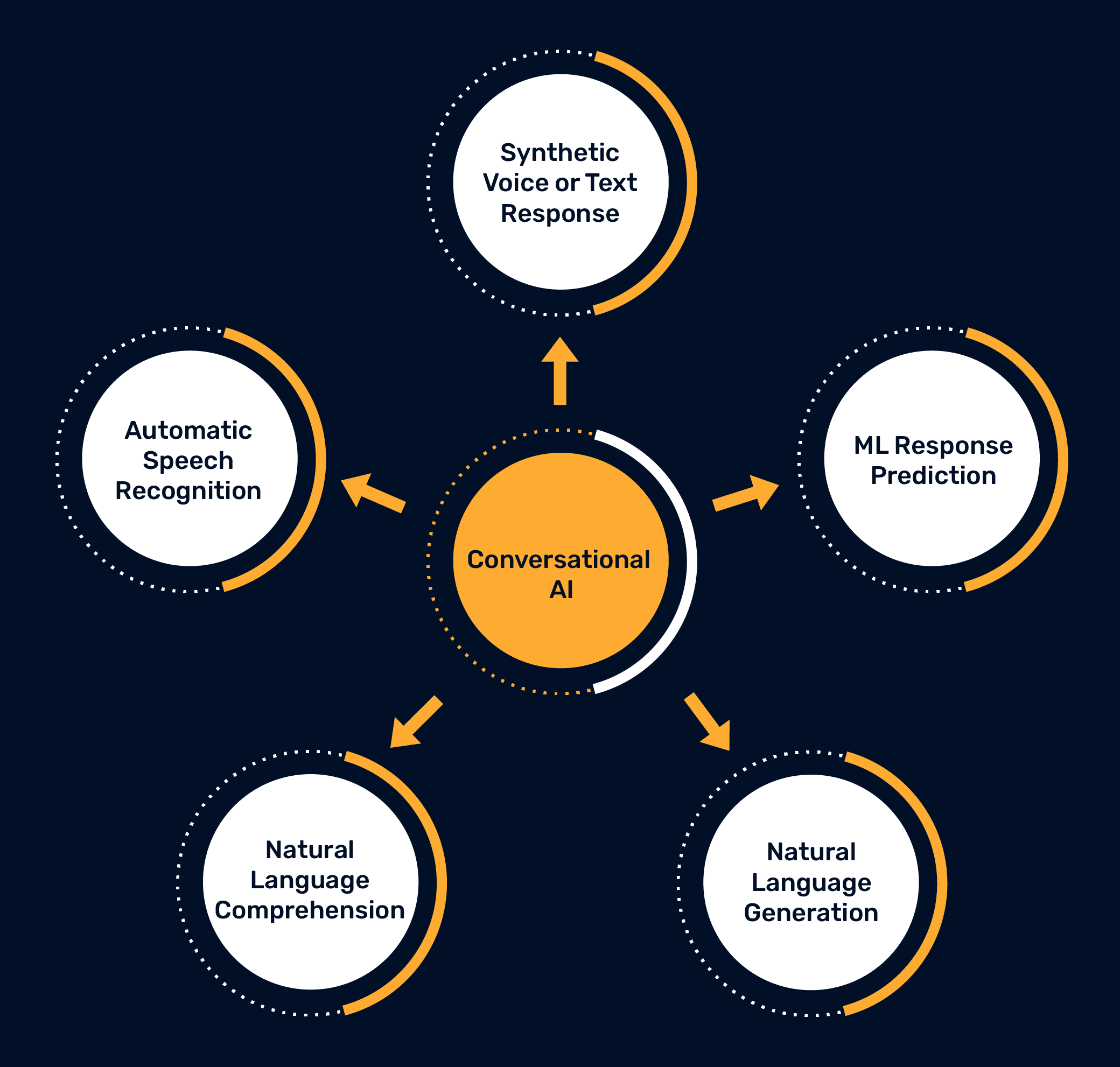Conversational AI in Customer Service: Why Your Business Needs It?

A business is all about satisfied customers. Consumers today are tech-savvy and know how technology can make everything accessible faster. So they expect instant resolution to their concerns. This is why relying only on human agents or legacy technology solutions for customer service processes is no longer going to cut it.
Conversational AI is paving a new way for faster and more effective customer communication for businesses across industries. Unlike a traditional rule-based chatbot that offers the same set of responses based on keyword-based scripts, conversational AI delivers answers by relying on customer intent using natural language processing, and the best part is that it gets smarter and better with each interaction using machine learning.
What is Conversational AI?
It enables machine-to-human interactions through virtual assistants, chat and voice bots using NLP, Automatic Speech Recognition (ASR), and Machine Learning (ML) technologies.
Your customers appreciate your responsiveness and availability. However, ensuring round the clock support can be an operational nightmare and expensive. Although rule-based chatbots do help to an extent but given their limited scope of interaction, they cannot cover a considerable breadth of user queries. Even with bot deployment and swift responses, 90% of users reported poor customer service, especially during the last two years (amid the pandemic), according to a survey conducted by Replicant.
Conversational AI addresses this challenge by taking away the dowdiness of bots. In a way, It empowers machine-to-customer interactions by deciphering consumer intent, and delivering better resolutions, thereby enhancing customer experiences with the brand.
Conversational AI chatbots and voice assistants are capable of responding to both voice and text inputs, allowing more convenience to the customers. So, the appeal of these conversational systems will never go unnoticed. They can be deployed for any industry; and across numerous use cases.
“According to Valuates Reports, the global conversational AI market size is expected to reach USD 32.62 Billion by 2030 from USD 5.78 Billion in 2020, with an annual compound growth rate of 20% in these 10 years.”
Two possible reasons for this growth:
- Messaging platforms with massive user bases like WhatsApp and WeChat are giving opportunities for businesses to interact with customers through seamlessly-designed chatbots.
- Growing popularity of voice assistants like Google Home, Alexa, Siri etc., are paving the way for businesses to create their own affordable speech-based assistants that easily integrate into their websites and other applications.
Components of Conversational AI
Conversational AI can identify the speech patterns to send responses in different languages, thanks to the incessantly improving AI, ML algorithms.
Microsoft predicts AI-powered chatbots will play a crucial role in the next-gen customer experience. More than 90% of customer interactions will happen through conversational AI-supported channels by 2025.
1. Natural Language Processing (NLP)
When a customer provides a text input, conversational AI utilizes the power of NLP to interpret the meaning. If the input is voice-based, it uses both NLP and Automatic Speech Recognition (ASR) to decode the meaning.
Once the meaning is comprehended, NLP sends the output and the advanced ML algorithms refine these responses for accuracy. This entire process is nothing but structuring the unstructured data into a readable format by the machines/computers in order to divulge the right response to humans.
2. Automatic Speech Recognition (ASR)
It is an important conversational AI component that helps your voice-based assistants receive inputs to drive meaningful conversations. It uses NLP to decode phonemes and words. With time, ASR will continuously evolve with the strenuous efforts of data scientists. Also, ASR and NLP combined will help the chatbots understand voice modulations and accents to decipher the mood and intent of the customer before giving a response.

3. Machine Learning
Being the sub-field of AI, ML has complex algorithms that make much smarter predictions for enhanced customer service. ML is a combination of datasets and algorithms, and the features are only going to improve with time. ML acts as a bridge between man and the machine and transforms machine outputs into a human-readable format.
Chatbot vs Conversational AI
Although chatbots can be powered by AI to make them more powerful, it must be noted that not all chatbots are AI-powered.
| Rule-based Chatbot | Conversational AI Chatbot | |
|---|---|---|
| 24X7 Online Support | ||
| Natural Language Processing | Keyword-based | |
| Multi-level Intent Detection | With If/Then Statements | |
| 3rd Party Integration | Limited | |
| Self Improving With Time | ||
| User Authentication | ||
| Voice Assistance | ||
| Multilingual | ||
| Context-based Navigation | Button-focused | |
| Privacy and Security Compliant |
Notable Benefits of Conversational AI
The biggest advantages of deploying conversational AI for customer services are – significantly improved customer experience and reduced cost-to-serve.
Conversational AI for customer service is extremely versatile, and it may be used in a range of customer care channels such as email, voice, chat, social media, and messaging platforms. Across industries, conversational AI is used by businesses to engage their customers and users throughout the customer journey with the brand.

1. Resource Optimization
A customer-focused business is on a constant hunt for new ways to improve the results for its clients. Undoubtedly, it wouldn’t be reluctant to spend more bucks on staffing its customer service department to reap the results quicker. But, the cost to the company, in this case, will definitely be on the higher side. If you go for conversational AI instead, you will not only cut these business costs but also save time for training the staff.
Apart from providing quick responses, conversational AI chatbots minimize the errors in replies and they are intelligent enough to not send repetitive messages for related queries.
2. Enhanced Customer Engagement
Voice assistants are the new way to interact across the business’ applications and devices without directly having to interact with individual enterprise websites or apps.
To explain this with a real-time example, let’s take the case of home assistants like Google Home or Alexa. We commonly use these to play music from our music systems, dim or brighten the lights, check weather reports. However, all these are just the beginning of further evolution.
Lately, a healthcare tech provider, has been deploying virtual voice assistants to offer healthcare services according to the insurance plan the patient is on. Users can embed this voice assistant into their wearables or smartphones and can be used for video appointments with doctors, administering medications, and other services. this healthcare tech provider uses facial recognition and advanced machine learning algorithms to perform these tasks.
3. Constant Improvement After Every Conversation
Conversational systems use an unstructured way of communication using NLP and machine learning algorithms. This means, after every session of conversation, the algorithms are fed with new data, which are them used to train the algorithms. This makes every interaction feel unique and relevant, while also reducing effort and resolution time. Besides this, the conversational AI systems go through continuous re-deployment to tackle new business issues.

Conclusion
Unlike rule-based chatbots, conversational AI don’t rely on human-generated scripts, which allows businesses to automate and scale highly personalized customer service resolutions.
Conversational AI comes with a bundle of advantages throughout your customer’s journey with your business. It streamlines your sales and support departments while reducing human intervention. Conversational AI chatbots will transform the way businesses work with their sophistication and myriad of functionalities. With time, conversational systems will evolve with advanced use cases, applications, paradigms; resulting in enhanced productivity for businesses.
At Techigai, we help you make a seamless entry into the world of AI chatbots and Intelligent Virtual Assistants (IVA) spectrum with our capabilities across NLP, machine learning, and AI. Techigai has been selected among the Top AI Companies by Designrush. Let’s talk.
“
We are no longer teaching humans to communicate with machines, but teaching machines how to communicate with humans.
Anonymous




